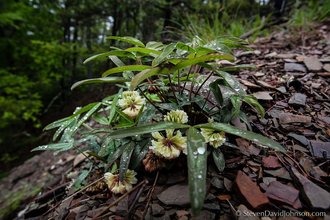
We are joining with other Allegheny-Blue Ridge Alliance members to ask your help to protect one of the wildest, most intact forests in the East.
Dominion’s proposed 600-mile Atlantic Coast Pipeline would cross 21 miles of the George Washington and Monongahela National Forests. Ask the Forest Service to reject Dominion’s efforts to shortcut the process for pipeline approval and Forest Plan amendment.
Before the ACP can be built across the national forests, the US Forest Service must (1) issue Special Use Permits and (2) amend forest management plans. To make these decisions, the Forest Service must review the impacts of the project according to the requirements of the National Environmental Policy Act and its own procedures. The Forest Service has consistently shown its commitment to a careful and thorough analysis of these types of projects, requiring applicants to provide complete and high quality information and making decisions based on its own timelines.
For the Atlantic Coast Pipeline, the Forest Service depends, in a significant way, on the work of Federal Energy Regulatory Commission, which is in charge of preparing an environmental impact statement. But on December 30, 2016 FERC published an incomplete and inaccurate Draft EIS that fails to address many Forest Service and public concerns. Most importantly, FERC improperly allows an applicant to defer submitting critical information until after a Certificate is issued or construction is underway, so the Forest Service won’t have the information needed to make its decisions.
On December 13, 2016 the Forest Service wrote to FERC describing its own procedural requirements for reviewing the ACP application, including a timeline that is longer than FERC’s schedule for project permitting. The Forest Service stated that, prior to making decisions on the project, all requested and needed data and plans must have been submitted and disclosed to the public.
Dominion’s proposed 600-mile Atlantic Coast Pipeline would cross 21 miles of the George Washington and Monongahela National Forests. Ask the Forest Service to reject Dominion’s efforts to shortcut the process for pipeline approval and Forest Plan amendment.
Before the ACP can be built across the national forests, the US Forest Service must (1) issue Special Use Permits and (2) amend forest management plans. To make these decisions, the Forest Service must review the impacts of the project according to the requirements of the National Environmental Policy Act and its own procedures. The Forest Service has consistently shown its commitment to a careful and thorough analysis of these types of projects, requiring applicants to provide complete and high quality information and making decisions based on its own timelines.
For the Atlantic Coast Pipeline, the Forest Service depends, in a significant way, on the work of Federal Energy Regulatory Commission, which is in charge of preparing an environmental impact statement. But on December 30, 2016 FERC published an incomplete and inaccurate Draft EIS that fails to address many Forest Service and public concerns. Most importantly, FERC improperly allows an applicant to defer submitting critical information until after a Certificate is issued or construction is underway, so the Forest Service won’t have the information needed to make its decisions.
On December 13, 2016 the Forest Service wrote to FERC describing its own procedural requirements for reviewing the ACP application, including a timeline that is longer than FERC’s schedule for project permitting. The Forest Service stated that, prior to making decisions on the project, all requested and needed data and plans must have been submitted and disclosed to the public.
 The ACP could harm special species, like Kate's Mountain Clover, found in Central Appalachian Shale Barrens along the route. Photo © Steven David Johnson
The ACP could harm special species, like Kate's Mountain Clover, found in Central Appalachian Shale Barrens along the route. Photo © Steven David Johnson It is critical that the Forest Service stay committed to the process and professional standards it upholds as stewards of our public lands. The Forest Service must take the time that it needs and the law provides to meet these standards. We believe that Dominion is extremely concerned about potential delays and Forest Service conditions. Dominion has repeatedly requested “expedited” review of this complex project which has so much potential to negatively impact both public and private lands.
Please voice your support for the U. S. Forest Service’s commitment to its requirements for a careful, thorough review of the pipeline application. Send statements of support to
Or send by mail to:
Nathaniel J. Davis, Sr., Deputy Secretary
FERC
888 First Street NE, Room 1A
Washington, DC 20426.
Please send a copy of your letter to VWC, too.
Please voice your support for the U. S. Forest Service’s commitment to its requirements for a careful, thorough review of the pipeline application. Send statements of support to
- Forest Service Chief, Thomas Tidwell, [email protected] and
- Eastern Regional Forester, Kathleen Atkinson, [email protected], and
- Southern Regional Forester, Tony Tooke, [email protected].
Or send by mail to:
Nathaniel J. Davis, Sr., Deputy Secretary
FERC
888 First Street NE, Room 1A
Washington, DC 20426.
Please send a copy of your letter to VWC, too.


 RSS Feed
RSS Feed